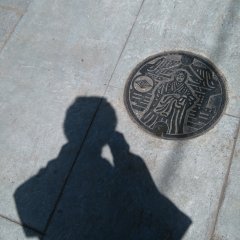
Kurume in Fukuoka enjoys an environment of sea, river, and mountain. It is further blessed with two sumptuous shrines by the Chikugo River, Bairinji and Suitengu, adjacent to each other. Bairinji occupies a large area on a hilltop, being the keystone temple for the rigorous Rinzan Zen Buddhism, as well as the memorial grounds of the Arima Clan.

The lower grounds are mostly the Main Shrine and other sacrosanct buildings, with the austere plain wood decor demonstrative of the higher order ascetic beliefs of Rinzan Zen. The filigreed carvings on the doors are the only concession to anything ornate.

On a higher back slope, are the five memorials of the Arima Clan who governed Kurume till 1868. Built between 1630-1655, looking like houses, they are similarly styled like the main temple, keeping company with loads of old tombs of generations of Arimas, scattered about and in lantern guarded rows. No creepy feeling, though, just deathly quiet.
There’s more of Bairinji when walking out of the temple and going to the back, where shaded by trees are a row of Buddha statues. More holiness on the road itself, where perched on a mound overlooking the temple, are remnants of statues. The whole place exudes a reverential atmosphere, maybe accumulated through the centuries since Bairinji’s inception in 1621. The exquisitely simple Zen gardens play their role, too.

Suitengu, the principal shrine of 200 or so other Suitengu Shrines, is 800 meters away.

The shrine originated in 1190 dedicated to the Deity of Water and associates, including the Kappa water sprites. Present premises began in 1650, perpetuating the same original beliefs and traditions, where Suitengu’s deities take charge of all water and maritime affairs, with safe childbirth somehow also a big part of worship.

The shrine’s buildings possess the same warm wood as Bairinji. The Main Shrine, just by the river, together with sub shrines and other edifices, a stone torii gate, sake barrels, magnificent trees, guardian dogs, stone lanterns, creates a sort of visual holiness.

A notable sub shrine is Maki Shrine, to commemorate a renowned Suitengu samurai priest and key imperial loyalist, Yasuomi Maki. They’ve made a bronze statue of him, as well as his nicely reproduced retirement house, together with a haiku monument.

Bairinji and Suitengu also have their floral glories, Bairinji, plum trees, and Suitengu, not to be outdone, camellia bushes. The beauty of the verdant scenery and surroundings of both shrines are augmented by proximity to the Chikugo River, with the river’s blue peeking through the giant trees around the shrines.
Not much shouting about Kurume as a tourist town, and maybe it isn’t. Places like Bairinji and Suitengu, though, speak for themselves, no shouting needed.































